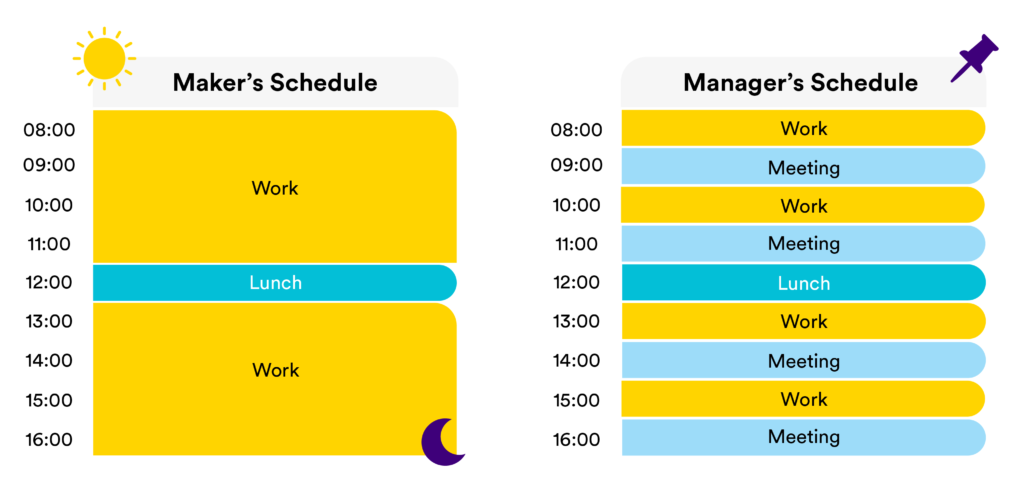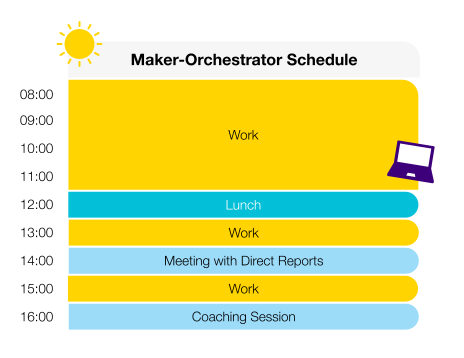-
5- MIN READ
Working in a Spectrum: (How to) Empower the Makers and Managers in Your Team
Makers’ and managers’ schedules often clash because of differences in work styles. It is possible to empower people’s functions to move in a spectrum.

When someone asks, “What’s your schedule like?”, how do you answer? Do you say that you often need half a day to get a major project done? Or that you have to attend multiple meetings that require collaboration and decision-making?
The Maker and the Manager
In 2009, Paul Graham published an essay describing the contrast of a manager’s schedule and that of a maker’s. A manager’s schedule is usually composed of multiple one-hour meetings divided into chunks with different contexts. A maker’s schedule, on the other hand, consists of long uninterrupted blocks of focus.

A manager’s schedule often consists of having to deal with other people and making decisions. His or her day consists of sprints—15-minute calls, 30-minute top-level syncs, hour-long meetings, and quick answers to emails. Their focus times are limited, requiring them to be quick on their feet and sort things out immediately. They have to make immediate decisions or action plans.
Makers, on the other hand, are great individual contributors. Give them a brief, the objectives, and a deadline, then your makers will go on creating the desired output. As much as possible, they do not want to be disturbed. Quick asks or sudden meetings are disruptive, causing them to experience difficulty returning to their focus state. (Think about taking some time to restart an engine.)
More than a decade since Graham’s essay was published, jobs have changed. Not everyone is a “100% manager” or a “100% maker.” “It’s not a black and white distinction,” Executive Coach Joe Dunn in Medium writes. “Managers get to make strategy, pitches, stories—and makers get to manage—making things is a team sport after all.”
Is it possible, then, for a person to have both maker and manager schedules?
The Maker-Orchestrator
The simple answer is yes. For example, Sharon functions in a manager’s schedule according to her job description. As Lead Developer, she handles a team across multiple projects. She regularly meets with them as a group or individually for coaching and mentorship. Sharon might also get pulled into collaboration meetings with other departments that require her team’s support. Considering her area of expertise, she provides insight on particular aspects. There are also projects wherein she needs to involve other teams, orchestrating responsibilities and timelines.
Sharon’s role has evolved more into a maker-orchestrator, whose tasks vary from working on documentation to providing support during meetings. While her role does involve meeting different people in sprints, that’s not all she does in a week. She sometimes operates on a maker’s schedule: doing tasks, such as conducting research and preparing reports, which require long hours of focus.

Knowing she has meetings with a set schedule, Sharon identifies days wherein she could work extensively on a project. She sets boundaries when people ask her for a quick call and suggests a preferred time that would not disrupt her focus. She clearly communicates her work style with her direct reports and her immediate supervisor and consistently delivers excellently.
Ministry of Supply, a tech-forward fashion brand, shared how it rebuilt its working culture by embracing the working styles of makers and managers. Instead of replicating office culture, they experimented with several methodologies that are possibly sustainable post-pandemic. Methodologies include the Scrum methodology, a popular framework in software product companies “to distribute project ownership and reduce one-on-one tactical management, which should instead focus on coaching and mentorship, alternate weeks, working sessions, and meeting-free days.”
Embracing Work Style Diversity at TaskUs
A people-first company, TaskUs recognizes ridiculously good makers, managers, and maker-orchestrators. The company has long-established meeting-free Fridays, which allows employees to focus on tasks at hand while also balancing work and personal life. Moreover, employees are encouraged to have weekly coaching sessions to improve work performance, build mentorship, and even share passion and purpose.
Global research shows that 89% of workers aged 22 to 25 and 83% of those aged 26 to 37 said they experienced more stress and anxiety as work spilled over into personal life due to the lack of boundaries. Majority of our teammates are still working from home and we understand that it is all the more important now to create an understanding of work styles.
Staying true to its core values of Continuous Self-Improvement and Always Strive for Excellence, TaskUs develops programs and projects that help employees achieve both their personal and professional goals. Among these are internal applications, training, and apprenticeship programs, such as the Business Insights and Data Science (BIDS) Bootcamp, Tuition Fee Reimbursement and Professional Development Programs, and Team Leader (TL) Certification programs, which can boost employees’ morale and confidence to aim for growth.
Sharon switches hats upon need—a skill that can be developed through experience. Everyone functions in a hybrid role, depending on the requirement. While there are roles that lean heavily on one side, every job would still need the skills of the other. Rather than placing employees in boxes, employers should acknowledge and empower their people to function in a spectrum. Every teammate can be both as long as they are empowered to do so.
Click here to learn more about Us.
References
-

TaskUs Named a Leader in Everest Group’s Trust and Safety Services PEAK Matrix® Assessment 2024
5-MIN READ -

TaskUs and V7 Announce Strategic Partnership To Enable Enterprise AI Product Delivery
5-MIN READ -

TaskUs and GCash partner to plant 10,000 coffee seedlings, support local coffee farmers
5-MIN READ -

TaskUs Elevates the Customer Experience With the Launch of AssistAI, Powered by TaskGPT
5-MIN READ -

TaskUs Named a Leader in Everest Group’s FCC Operations Services PEAK Matrix® Assessment 2024
5-MIN READ -

TaskGPT Launches in Zendesk Marketplace, Giving Customers Access to Leading Generative AI-fueled Customer Service Solutions
5-MIN READ -

TaskUs recognized as the Leader in the 2023 SPARK MatrixTM for Financial Crime and Compliance (FCC) Operations Services by Quadrant Knowledge Solutions
5-MIN READ -

TaskUs Scores Designation As A “Major Contender” on Everest Group’s Banking Operations – Services PEAK Matrix® Assessment 2023
5-MIN READ
We exist to empower people to deliver Ridiculously Good innovation to the world’s best companies.
Useful Links



